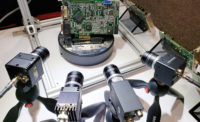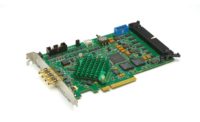In 2000, the Camera Link standard was adopted as one of the first machine vision standards. Now more than 17 years old, it has seen some changes and several other standards have emerged and been adopted by the industry.
After more than twenty years of dutiful service in machine vision, Camera Link, USB 2.0 and FireWire have seen several industry changes and demands that may indicate that their days are limited. In fact, it was Steve Jobs who declared FireWire dead back in 2008, yet it is still somewhat prevalent in the industry. While prevalence can be good, it’s the new projects that are the lead indicator of market direction. In addition to these three, GigE Vision, 10GigE Vision and CLHS are other standards in the market that will be impacted by the future. While these older interfaces remain adequate for lower-end systems, CoaXPress and USB3 Vision have displaced them in today’s more demanding, high bandwidth applications. These two new heavyweights are engaged in a battle for global vision supremacy with the prize being millions of end-users’ dollars.
First, some background: The AIA launched the USB3 Vision standard in 2013 based on USB 3.0 and followed up with USB 3.1 (Gen 1 and 2) in 2015 that doubles USB 3.0 theoretical transfer speeds to 10 Gbps. The Japan Industrial Imaging Association formally introduced CoaXPress V1.0 back in 2010 and V1.1 in 2013. CoaXPress V2.0 is due to be released Q3 2017 that will add two speeds: 10 Gbps (CXP-10) and 12.5 Gbps (CXP-12). Uplink speed will also be doubled for CXP-10 and CXP-12, allowing trigger rates over 500 kHz without requiring a dedicated high-speed uplink cable.
As the market has shaken out, USB3 Vision has largely become the go-to standard in applications with bandwidth requirements of 40 MB/s to 300 MB/s, unseating GigE Vision (100 MB/S) as well as Camera Link Base (255 MB/S), FireWire (400 MB/S) and USB 2.0 (60 MB/S). Conversely, CoaXPress is filling the gap for those applications calling for greater than 300 MB/s especially where longer cable length is needed in machine vision, medical imaging, life sciences, broadcast and defense. The growth of each of these standards in new projects over the last few years has steadily increased.
Neither CoaXPress nor USB3 Vision is best for all applications in meeting performance, price and design requirements. For the purpose of this article, though, we will examine them head-to-head on the critical factors of throughput, cables, power, I/O synchronization and overall budget. We will also look at a new twist to the CoaXPress plot: the development of single-link CXP frame grabbers aiming to replace USB 3.0 in mid-range applications.
THROUGHPUT
USB3 Vision refers to the updated version of USB 3.0. The new USB 3.1 interface reflects the addition of an optional 10 Gbps transfer rate. USB 3.1 has two versions: Gen 1 or SuperSpeed USB, and Gen 2 or SuperSpeed USB 10 Gbps. For the most part, there are no differences between USB 3.1 Gen 1 and USB 3.0 which operate at the same speeds of 400 MB/s. CoaXPress has a high speed downlink of up to 625 MB/s (6.25Gbps) per cable for video, images and data, plus a lower speed, 20Mbps uplink for communications and control. While a single CXP-6 high-speed link delivers speeds of 6.25Gbps, the standard offers a number of different bit rates ranging from CXP-1 (1.25Gbps) to CXP-6 (6.25Gbps) with maximum camera-to-computer distances from 212 m (CXP-1) to 68 m (CXP-6).
CABLES
CoaXPress combines the simplicity of off-the-shelf 75-ohm coaxial cable with high-speed serial data technology. In addition to making it an excellent choice for repurposing the coaxial cable infrastructure of older analog systems in the migration to digital, coaxial cable allows the use of inexpensive standard BNC or DIN1.0/2.3 connectors in lengths up to 100 meters in length at 3.125 Gbps and 40 meters at 6.25 Gbps. USB3 Vision takes advantage of the ubiquitous USB plug-and-play interface found on PCs and other consumer electronics. One significant drawback of USB3 Vision is that its cable is significantly limited by its shorter length requirement. Standards restrict A male to B male cable lengths to three meters maximum. Cables with USB 3.0 Micro B plugs are limited to one meter maximum for compliance. Although these cable lengths are sufficient for typical USB connections use at home or offices, they present serious issues in machine vision. Optical repeaters have been added to systems to extend USB cable length, as has active electrical cabling. Given the high cost, it remains to be seen just how practical this solution is.
POWER
CoaXPress allows video, camera control for triggering, and power to be delivered via a single coaxial cable. Power over CoaXPress applies a constant 24V DC voltage to the cable core, without influencing the signal integrity, to provide up to 13W per cable. USB3 Vision delivers support for powered devices of up to 4.5W. However, small variations in the amount of available power, due to differences in motherboard design and the USB host controller chip, are a factor to consider depending on the amount of power required by a camera.
I/O SYNCHRONIZATION
USB3 Vision systems operate without a frame grabber and therefore rely solely on native interfaces built into PCs. I/O synchronization can be more difficult without a frame grabber for the brokering of communication signals and triggers, leading to latency in signal travel time, as well as image jitter. In a CoaXPress system, the frame grabber is the master. It ensures that all cameras get the trigger signal at the precise same time to acquire an image. Frame grabbers can synchronize multiple cameras very fast, since time required to trigger the cameras is the propagation speed of the electrical signal through the wire.
PRICE
On the surface, it would appear USB3 Vision is the likely winner on price. After all, there are frame grabbers to buy. Cabling and USB3 interfaces are inexpensive, however, this doesn’t take into account the added expense of repeaters, active cables or fiber optic cables to extend short cable length. It also doesn’t factor in the recent drop in prices for CoaXPress cameras which are now comparable with USB3 Vision models. CoaXPress allows the use of common RG59 and RG6 coaxial cable, which is relatively inexpensive. Also, because coaxial cables are common in vision systems that deploy analog cameras, CoaXPress enables a seamless upgrade to digital cameras. In fact, a user simply replaces only the analog camera and frame grabber to gain CoaXPress transmission rates. When comparing systems, it’s hard to simply ask yourself the dollars/MB transfer cost as there’s so much more. It’s best to ask “Which system does what I need?” and then the ROI will look after itself.
While a battle between CoaXPress and USB3 Vision is brewing in the 200-400MB/S applications, it is also possible that CoaXPress will pose a threat to USB3 Vision’s stronghold on the mid-range 40 MB/s to 100 MB/s market as it transitions away from GigE Vision. A new breed of low-cost single link frame grabbers have been introduced to support slimmed down, cooler running and less expensive CoaXPress single link cameras as small as 29mm cubes. While small, the cameras still get 6.25 Gb/S worth of data over the link, almost twice the real world data rate of the USB3 Vision standard and significantly quicker (up to six times) than the latest GigE Vision data rates. Combining the two components means the CoaXPress system can compete on price, while exceeding cable lengths and provide a host of features missing from USB3 Vision and GigE Vision systems, such as triggers, encoders, strobes, waveform generators and quadrature encoder support.
A well-designed machine vision system can last up to ten years and, because of this, newer technologies can take some time to be integrated to their full potential. While there’s still an abundance of GigE Vision and Camera Link systems, the industry is seeing the changeover happening to USB3 Vision and CoaXPress, depending on the direction the customer wishes to take.
CONCLUSION
The scope of machine vision is so large, from inspecting a DNA sample to checking if a door is flush on a new car, or the paint is evenly dispersed. Because of the large scope, there can be no true winner of this battle of standards. Some companies need the best resolution being transferred at the highest speeds, while others are more content with a system that doesn’t cost the earth yet is perfectly adequate with their needs. The distance between the camera and the PC is always going to be a factor, and while both standards can achieve it, one is significantly more expensive on the cable side. Some companies like the portability of the laptop and a plug-and-play solution. However, one thing is clear, and that is that we don’t need six or ten standards. Most of the machine vision needs can be covered by these two standards, and over time, as they evolve, they may be able to cover the entire gamut themselves, or settle for a third standard which covers the gaps.














